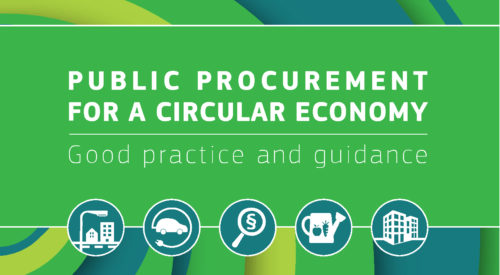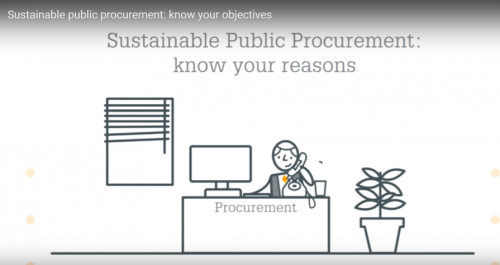Europe’s public authorities are major consumers, with public procurement expenditure covering about 16% of European Gross Domestic product. By using their purchasing power to choose environmentally friendly goods, services and works – a practice called Green Public Procurement (GPP) or green purchasing – they can make an important contribution to sustainable consumption and production.
GPP, including sustainable procurement initiatives, tools and guidance, has a key role to play in the EU’s efforts to become a more resource-efficient economy. It can help stimulate a critical mass of demand for more sustainable goods and services which otherwise would be difficult to get onto the market. GPP is therefore a strong stimulus for eco-innovation and circular economy.
“Green Public Procurement is a process, whereby public authorities seek to procure goods, services and works with a reduced environmental impact throughout their life cycle when compared to goods, services and works with the same primary function that would otherwise be procured.”
(COM (2008) 400 Public procurement for a better environment)
Understanding Green Public Procurement in the EU
In the Communication “Public procurement for a better environment” (COM (2008) 400) the Commission recommended the creation of a process for setting common GPP criteria. The criteria used by EU Member States should be similar to avoid a distortion of the single market and a reduction of EU-wide competition. Having common criteria reduces considerably the administrative burden for economic operators and for public administrations implementing GPP. Common GPP criteria are of a particular benefit to companies operating in more than one Member State as well as SMEs (whose capacity to master differing procurement procedures is limited).
The basic concept of GPP relies on having clear, verifiable, justifiable and ambitious environmental criteria for products and services in the public procurement process, based on a life-cycle approach and scientific evidence base. The European Commission and a number of EU Member States have developed guidance in this area, in the form of national GPP criteria. These are based on data from an evidence base, on existing ecolabel criteria and on information collected from stakeholders of industry, civil society and Member States. The evidence base uses available scientific information and data, adopts a life-cycle approach and engages stakeholders who meet to discuss issues and develop consensus.
The GPP approach is to propose two types of criteria for each sector covered:
- the core criteria, which are suitable for use by any contracting authority across the Member States, address the key environmental impacts, and are designed to be used with minimum additional verification effort or cost increases;
- the comprehensive criteria, which are suitable for those who wish to purchase the best environmental products available on the market, and may require additional verification effort or a slight increase in cost compared to other products with the same functionality.
GPP does not set out to detail each and every aspect of a product’s life cycle. Rather, by judicious use of published ecolabel and/or life cycle information, it focuses on key aspects.
Overall, public procurement can be instrumental in addressing environmental problems such as:
- Deforestation, (e.g. through the purchase of wood and wood products from legally harvested and sustainably managed forests)
- Greenhouse gas emissions (e.g. through the purchase of products and services with a lower CO2 footprint throughout their life-cycle)
- Water use (e.g. through choosing more water-efficient fittings)
- Energy efficiency and resource use (by choosing products which are more efficient and implementing environmentally conscious design principles, e.g. cradle-to-cradle)
- Air, water and soil pollution (by controlling chemicals and limiting the use of hazardous substances)
- Waste (by specifying processes or packaging which generate less waste or encouraging reuse and recycling of materials)
- Sustainable agriculture (e.g. by purchasing organically produced food)
Implementing Green Public Procurement in the EU
Since 2008, the Commission has developed more than 20 common GPP criteria covering various product and service groups. The priority sectors for implementing GPP were selected through a multi-criteria analysis including: scope for environmental improvement; public expenditure; potential impact on suppliers; potential for setting an example to private or corporate consumers; political sensitivity; existence of relevant and easy-to-use criteria; market availability and economic efficiency. The criteria are regularly updated (see links in the box to the right).
Further to the common GPP criteria and accompanying technical reports, a number of resources have been developed to assist public authorities in the implementation of GPP:
- The Buying Green! Handbook on Environmental Public Procurement giving advice to purchasers on legal and practical aspects of GPP;
- A GPP Helpdesk to respond directly to stakeholders’ enquiries;
- A News-Alert featuring the most recent news and events on GPP;
- A list of responses to Frequently Asked Questions (FAQs);
- A glossary of key terms and concepts related to GPP;
- The GPP website with links to these resources plus studies, projects, videos, networks, national links, GPP examples, court cases and legal and policy background, training materials and documents for new criteria development.
The benefits associated with GPP implementation are not limited to environmental impact but can also include social, health, economic or political benefits. Some examples of actual and potential benefits generated by European authorities through GPP are presented below:
- the City of Vienna saved €44.4 million and over 100,000 tonnes of CO2 between 2004 and 2007, through its EcoBuy programme;
- three million tonnes of CO2 would be saved in the Netherlands alone if all Dutch public authorities applied the national Sustainable Public Procurement criteria, which include green criteria, while public sector energy consumption would be reduced by 10%;
- If all IT purchases in Europe followed the example of the Copenhagen City Council and the Swedish Administrative Development Agency, energy consumption would be cut by around 30 terawatt hours – roughly the equivalent of four nuclear reactors;
- £40.7 million (€47.2 million) could be saved in the UK if the proposed Government Buying Standards (GPP criteria) are applied by all central government departments and executive agencies, according to a cost-benefit analysis which monetised the potential impacts;
- CO2 emissions would be cut by 15 million tonnes per year if the whole EU adopted the same environmental criteria for lighting and office equipment as the City of Turku, Finland – reducing electricity consumption by 50%.
INTERNATIONAL DIMENSION
Over the last several years, there has been growing political commitment to promote GPP at international level, with sustainable procurement policies having been launched in many OECD countries outside the EU (USA, Japan, Canada, Australia, and South Korea), as well as in rapidly developing countries (such as China, Thailand, and Philippines). Already in 2002, the OECD adopted a Recommendation on green public procurement, while in the same year, as a follow-up to the Johannesburg World Summit on Sustainable Development, a Marrakech Task force on sustainable procurement was created with the aim of spreading sustainable (green) public procurement practices. More recently, the 10YFP / One Planet Network Programme on Sustainable Public Procurement (SPP) was developed as a global multi-stakeholder platform supporting the implementation of SPP around the world.
Transfer of EU experience (Replication potential outside the EU)
The 10YFP / One Planet Network SPP Programme, led by UN Environment together with Local Governments for Sustainability (ICLEI) and the Korean Environmental Industry and Technology Institute, builds synergies between diverse partners to achieve the SDG target on SPP. Examples of their activities include the Asia Pacific Green Public Procurement Partnership Project, which supports the institutionalisation and implementation of green public procurement and eco-labelling of ASEAN countries, and the project “Towards a Sustainable Public Procurement System in Uruguay”.
Another international cooperation initiative supported by the EU is the Sustainable Public Procurement and Ecolabelling (SPPEL) project, implemented by UN Environment. The project combines the two elements of ecolabelling and sustainable public procurement to stimulate the demand and supply of sustainable products in countries across the world. More specifically, the project provides capacity development and technical assistance to public and private sectors on the development and implementation of SPP policies and the use of eco-labelling.
SPP is also promoted under the EU SWITCH programme, implemented in Asia, Africa and the Mediterranean region. This is achieved by sharing of relevant knowledge, know-how and best practices under the programme’s policy support components, as well as through the implementation of grant projects aiming at encouraging a switch to sustainable consumption patterns and behaviour amongst consumer groups, civil society stakeholders and the public sector.
—
|
|
Disclaimer:
This publication has been produced with the assistance of the European Union. The contents of this publication are the sole responsibility of the consortium implementing the SWITCH to Green facility (led by sequa gGmbH with GFA Consulting and Pracsis) and can in no way be taken to reflect the views of the European Union.


